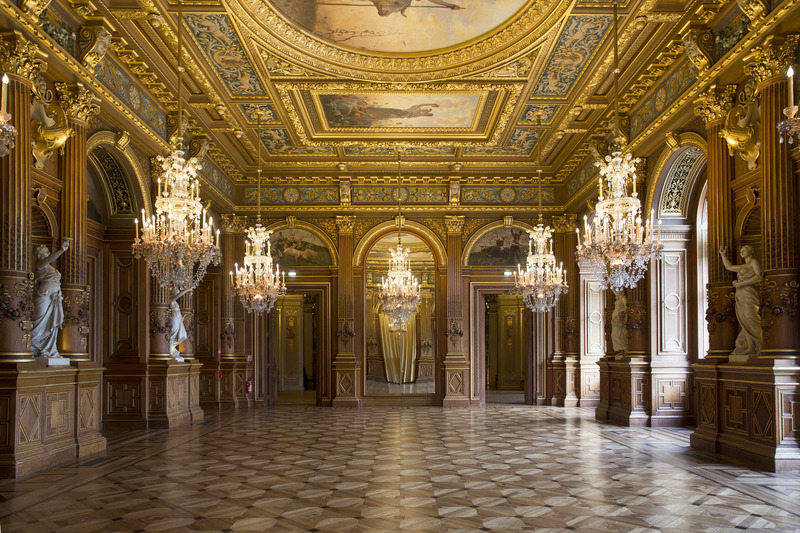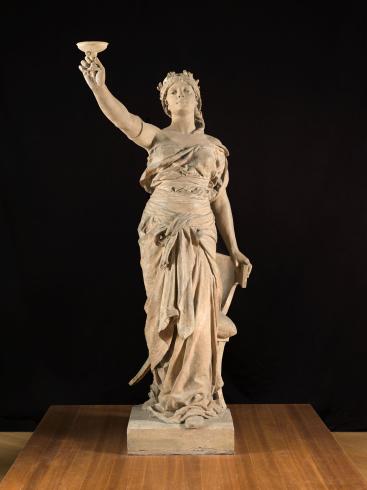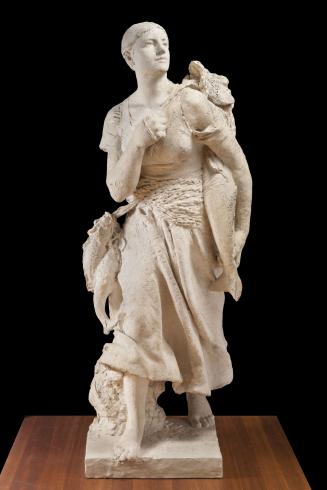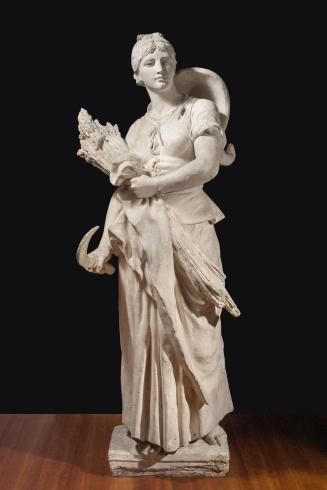During the bloody week of 22 to 28 May 1871, a number of Parisian monuments were set alight by the Communards, in particular those associated with an image of authority. These included the Hôtel de Ville, which burned on 24 May. The following year, the new municipal council launched a competition for renewal of the building. Théodore Ballu, head architect of works at the City of Paris, was in charge of the architectural plans. Although the new building was officially inaugurated on 13 July 1882, it was far from complete: the programme for interior decoration of the ceremonial rooms was only finalised in 1888, and its execution continued until 1906.
To decorate the Grand Dining Room (now the Georges Bertrand room), a huge rectangular area with oak-panelled walls, the municipality choose the theme of glorification of the Earth, the nurturing mother of Humanity.
The painted decor
The central ceiling represents a ploughman greeting the sun as it rises on the horizon, while the two side panels symbolise the two essential Foods, bread and wine, represented by Grape Picking and Harvesting. The overdoors feature allegories of other Foods: strawberries, fish, meat, and garden vegetables.
The sculptures
 The sculpted decor also explored this subject, with six statues in white marble placed in large mural recesses. These represent allegories of Hunting, Singing, Grape Picking, Toasting, Fishing and Harvesting. Full-size plaster models of the last three sculptures are now held by the Petit Palais. These six statues illustrate the stylistic eclecticism prevalent in the sculpted decor of the Hôtel de Ville.
The sculpted decor also explored this subject, with six statues in white marble placed in large mural recesses. These represent allegories of Hunting, Singing, Grape Picking, Toasting, Fishing and Harvesting. Full-size plaster models of the last three sculptures are now held by the Petit Palais. These six statues illustrate the stylistic eclecticism prevalent in the sculpted decor of the Hôtel de Ville.
Begun in 1883 by Jean Antoine Marie Idrac and completed by Jules Alexis Coutan, Le Toast (Toasting) is symbolised by a woman rising from her chair while lifting her glass to offer a toast. The figure’s hair and attire are theatrical in form, and the curves of her silhouette and the folds of her clothing already suggest the graceful lines of Art Nouveau.
La Pêche (Fishing) by Alexandre Falguière, representing a woman in a dress belted with a fishing net from which a few fish are escaping, is modelled, on the contrary, with rusticity and schematism.
In the work by Henri Chapu, a former artist in residence at the French Academy in Rome, La Moisson (Harvesting) is embodied by a strong-armed peasant, dressed in a heavy skirt and holding in her arms a sheaf of wheat and a sickle. In the facial features, the classical lines of the drapery, and the slight contrapposto pose, the work reflects the influence of academic training based on the study of Antiquity.
La Chasse (Hunting), Le Chant (Singing) and La Vendange (Grape Picking) were entrusted, respectively, to three other artists, Louis-Ernest Barrias, Jules Dalou and Gustave Crauck.
H. D.

City of Paris municipal collection's website
The collections portal can be used to search the collections of Paris’s 14 municipal museums (approximately 336,000 works, including 43,000 belonging to the Petit Palais).
It is also possible to download around 12,000 images of the museum’s works free of charge.
Access the Museums of the City of Paris collections portal
Extern databases
Discover a selection of databases online presenting works from the Petit Palais or documents concerning the history of the museum.



